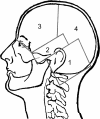Region-specific radiotherapy and neuropsychological outcomes in adult survivors of childhood CNS malignancies
- PMID: 20716593
- PMCID: PMC3098024
- DOI: 10.1093/neuonc/noq104
Region-specific radiotherapy and neuropsychological outcomes in adult survivors of childhood CNS malignancies
Abstract
Childhood cancer survivors exposed to CNS irradiation are at increased risk for neurocognitive deficits; however, limited data exist linking outcomes with region-specific exposure to CNS irradiation. We report associations between region-specific radiation dose and self-reported neurocognitive and health-related quality of life (HRQOL) outcomes in 818 adult survivors of childhood central nervous system (CNS) malignancies from the Childhood Cancer Survivor Study. Survivors were compared with a sibling group and national normative samples to calculate standardized scores. Cumulative radiation dose was calculated for 4 specific brain regions. Logistic regression was used to estimate the association between radiation dose to specific brain regions and outcome measures of functional impairment adjusted for clinical and demographic factors, including sex and age at diagnosis. High radiation dose levels to temporal regions were associated with a higher risk for memory impairment (radiation doses ≥30 to <50 Gy: OR, 1.95; 95% CI, 1.01-3.78; dose ≥50 Gy: OR, 2.34; 95% CI, 1.25-4.39) compared with those with no radiation exposure. No such association was seen with radiation exposure to other regions. Exposure to temporal regions was associated with more social and general health problems, whereas exposure to frontal regions was associated with general health problems and physical performance limitations. Adult survivors of childhood CNS malignancies report higher rates of neuropsychological and HRQOL outcomes, which vary as a function of dose to specific neuroanatomical regions. Survivors with a history of radiation exposure to temporal brain regions are at increased risk for impairment in memory and social functioning.
Figures



References
-
- Gurney JG, Smith MA, Bunin GR. CNS and miscellaneous intracranial and intraspinal neoplams (ICCC III) In: Ries LAG, Smith MA, Gurney JG, Linet M, Tamra T, Young JL, Bunin GR, editors. National Cancer Institute. Bethesda MD: Cancer Statistics Branch, Cancer Surveillance Research Program, Division of Cancer Control and Population Sciences; 1999. pp. 51–63. Cancer Incidence and Survival Among Children and Adolescents: United States SEER Program 1975–1995.
-
- Armstrong GT, Liu Q, Yasui Y, et al. Long-term outcomes among adult survivors of childhood central nervous system malignancies in the Childhood Cancer Survivor Study. J Natl Cancer Inst. 2009;101(13):946–958. doi:10.1093/jnci/djp148. - DOI - PMC - PubMed
-
- Reeves CB, Palmer SL, Reddick WE, et al. Attention and memory functioning among pediatric patients with medulloblastoma. J Pediatr Psychol. 2006;31(3):272–280. doi:10.1093/jpepsy/jsj019. - DOI - PubMed
-
- Ellenberg L, Liu Q, Gioia G, et al. Neurocognitive status in long-term survivors of childhood CNS malignancies: a report from the Childhood Cancer Survivor Study. Neuropsychology. 2009;23(6):705–717. doi:10.1037/a0016674. - DOI - PMC - PubMed
-
- Zebrack BJ, Gurney JG, Oeffinger K, et al. Psychological outcomes in long-term survivors of childhood brain cancer: a report from the childhood cancer survivor study. J Clin Oncol. 2004;22(6):999–1006. doi:10.1200/JCO.2004.06.148. - DOI - PubMed
Publication types
MeSH terms
Grants and funding
LinkOut - more resources
Full Text Sources
Medical

